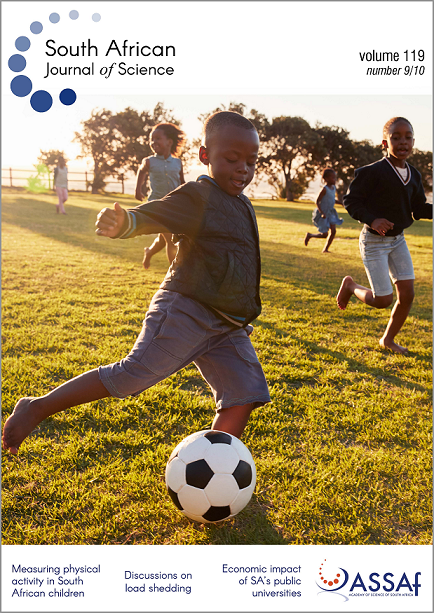Association of accelerometry-based and self-reported physical activity with cardiovascular risk in South African children
DOI:
https://doi.org/10.17159/sajs.2023/15494Keywords:
physical activity, accelerometry, self-report, cardiovascular health, children, South AfricaAbstract
The burden of non-communicable diseases is increasing, with risk factors emerging early in life. Physical activity reduces cardiovascular risk, but limited evidence exists for children from lower-income countries and mostly relies on self-reported methods that might be inaccurate and biased. We aimed to compare self-reported and accelerometer-measured physical activity in relation to cardiovascular risk markers in children from underserved communities in South Africa. We analysed cross-sectional data from 594 children aged 8 to 13. Physical activity was measured via accelerometry and the Physical Activity Questionnaire for Older Children (PAQ-C). Correlation analyses and linear regression models examined the relationship between accelerometer-measured and self-reported physical activity and their association with cardiovascular risk markers (body mass index, blood pressure, blood lipid profile and glycated haemoglobin). Results show a positive but weak correlation between PAQ-C scores and accelerometer-measured moderate-to-vigorous physical activity (MVPA). MVPA was inversely associated with body mass index, whilst sedentary behaviour correlated positively with lipid levels. PAQ-C scores were inversely associated with systolic blood pressure. The comparison of self-reported and accelerometer-measured physical activity in children from Gqeberha, South Africa, revealed inconsistencies in their correlation and association with cardiovascular risk markers. Accelerometry provided a more accurate cardiovascular risk estimation than PAQ-C, although associations were weak. Further, longitudinal studies should investigate the predictive power of both methodologies. These findings inform researchers and public health practitioners in the choice of method for physical activity appraisal beyond practical considerations, especially when combined with cardiovascular risk and in lower-income settings.
Significance:
We explore two widely used methods to assess physical activity levels in children. By comparing both methods, we expose inconsistencies in their correlation and association with cardiovascular risk markers. These data can guide researchers and public health practitioners in the use of one method beyond practical considerations. Whilst this work focuses on children from marginalised areas of South Africa, the issues explored are of relevance to other lower-income settings.
Open data set: https://doi.org/10.5281/zenodo.7217145
Published
Issue
Section
License

All articles are published under a Creative Commons Attribution 4.0 International Licence
Copyright is retained by the authors. Readers are welcome to reproduce, share and adapt the content without permission provided the source is attributed.
Disclaimer: The publisher and editors accept no responsibility for statements made by the authors
How to Cite
- Abstract 989
- PDF 495
- EPUB 326
- XML 169












.png)